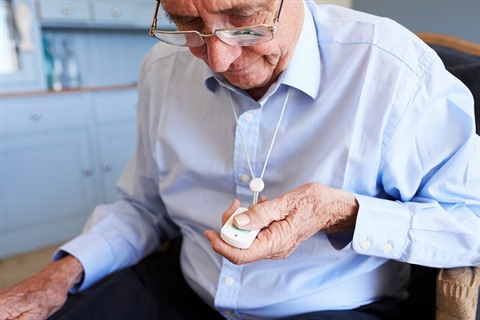A guide to personal alarms
Published on 15 November 2023

Personal alarms are designed to provide people with peace of mind and a sense of security as they age. They can protect a person’s safety by allowing them to quickly and easily call for help in the event of an emergency, such as a fall.
“I once had a client who was reliant on a wheelchair for mobility and had a fall in the shower while trying to transfer from the shower chair back to their wheelchair,” says AccessCare nurse, Kate. “The client was able to use their personal alarm to call for assistance, and Ambulance Victoria was notified and arrived to help them back into their wheelchair.
“Thankfully no serious injuries were sustained, but without the alarm, the client could potentially have been on the floor in the bathroom for many hours.”
So, how exactly do personal alarms work and how can they help older people to maintain their independence? This guide is designed to help demystify these potentially life-saving devices.
What are personal alarms?
In a nutshell, personal alarms are assistive technology devices. They are small and wearable, and typically take the form of a pendant to be worn around the neck, or a wrist band to be worn like a watch.
There’s a wide range of personal alarms on the market, but most share similar features. They are usually waterproof so they can be worn in the shower or a bath, and they include a button that can be pressed in an emergency. More advanced alarms can also feature GPS functionality and falls detection technology.
Some alarms will only work when a person is in their home, while others will function when you are out in the community as well.
The main purpose of a personal alarm is to help protect people from falls. According to the AIHW, falls are Australia’s leading cause of injury hospitalisation and death, with hospitalisation due to falls occurring more frequently in older people, and most commonly within the home.
Importantly though, alarms aren’t intended to stop falls from happening or to prevent injury if falls occur. Instead, they help to alert a person’s family or friends or emergency services if someone needs help.
As such, the people who most benefit from personal alarms are those who live on their own and who have a chronic health condition or a disability. Additionally, they can give carers peace of mind by knowing that should something happen to their loved one, they will be notified with the touch of a button.
How do personal alarms work?
Depending on your personal situation, you may be suited to either a monitored personal alarm or a self-monitored personal alarm (also called an auto-dial personal alarm). The key difference is that a monitored alarm is connected to a professional emergency response centre that is available 24/7 while a self-monitored alarm features a pre-programmed list of friends and family who, if the alarm is activated, are called by the device in order until someone answers.
As such, monitored alarms are typically recommended for people who have limited social supports or whose family and friends live far away. When an alarm is activated, the response centre will attempt to contact you, and if they cannot reach you, they will either contact Ambulance Victoria or a family member – whichever was determined in your plan when you first set up your alarm.
It’s also worth noting that some alarms will only activate when the button is pressed, while others have features built in that can detect a fall and activate on their own. This can be vitally important if a person loses consciousness when they fall or is unable to reach their alarm.
Additionally, some monitored alarms also require people to press the button each morning to notify the response centre that they are ok; otherwise, the person will be called to ensure they are not in need of assistance.
How to get a personal alarm
There are two key ways to get a personal alarm: you can purchase one privately, or you may be able to apply for one through the state-funded Personal Alert Victoria (PAV) program.
In order to apply for the PAV program, your eligibility must first be assessed. This is usually done through your local council, community health service or aged care assessment service. To be successful, applicants must meet all three of the following mandatory criteria:
- they must need and agree to daily monitoring
- they must be capable of using the PAV device and be willing to wear it at all times
- they must live alone or are alone for most of the day or evening, or live with a person who cannot get to the phone in an emergency or who is unable to use the phone
Additionally, they must also meet at least two of the following criteria:
- have fallen at least once and needed medical attention in the past six months
- suffer from a major medical condition or chronic condition that puts them at risk of medical emergencies or has some ongoing effect on health or wellbeing
- take six or more different medications permanently prescribed by a medical practitioner or doctor
If you’re interested in finding out more about the PAV alarms, please talk to your Aged Care Advisor or contact your local council to see if you’re eligible.
If you would like to find out more about personal alarms, please reach out to the AccessCare team by calling 1300 819 200.